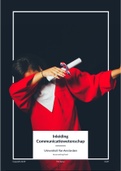Inleiding
Communica.ewetenschap
Universiteit Van Amsterdam
Samenvatting Deel I
Copyleft 2019 Tim Arisz ICW
,Inhoudsopgave
Week 1
- Hoofdstuk 1: Griffin, E., Ledbetter, A., & Sparks, G. (2015). Launching your study of communication theory
- Introduction
- Begrippen: Theory, Communication, Text, Communicatie modellen, Machtige media, Empirische
cyclus
Week 2
- Hoofdstuk 8: Griffin, E., Ledbetter, A., & Sparks, G. (2015). Cultivation theory of George Gerbner
- PDF: Griffin, E. (1994). Social learning theory of Albert Bandura
- Begrippen: Cultivation Theory, Cultivation analysis, Accessibility principle,
Mainstreaming, Resonance, Heavy viewers, Cultivation differential, Meta-
Aanalysis, Mean world syndrome
- Literatuurvragen week 2
Week 3
- Hoofdstuk 5: Griffin, E., Ledbetter, A., & Sparks, G. (2015). Media ecology of Marshall McLuhan
- PDF: Schönbach, K. (2001). Myths of media and audiences: Inaugural lecture as professor of general
communication science
- PDF: Davison, W. P. (1983). The third-person effect in communication.
- Begrippen: Media Ecology, Media, Medium, Dangerous New Media Myth, Wonderful New
Media Myth, Third person hypothesis, Third person effect
- Literatuurvragen week 3
Week 4
- Hoofdstuk 7: Griffin, E., Ledbetter, A., & Sparks, G. (2015). Uses and gratifications of Elihu Katz
- Begrippen: Uses & Gratifications, Uniform Effects Model, Straigth Line Effect, Types of Uses,
Typology, Parasocial Relationship
- Literatuurvragen week 4
Week 5
- Hoofdstuk 3: Griffin, E., Ledbetter, A., & Sparks, G. (2015). Social judgement theory of Muzafer Sherif
- Hoofdstuk 4: Griffin, E., Ledbetter, A., & Sparks, G. (2015). Elaboration likelihood model of Richard Petty &
John Cacioppo
- PDF: Harmon-Jones, E. (2002). A cognitive dissonance theory perspective on persuasion. In J. Price Dillard &
M. Pfau (Eds.), The persuasion handbook: Developments in theory and practice
- Begrippen: Social Judgement Involvement, Ego-involvement, Cognitive map, Contrast,
Assimilation, Boomerang effect, Reference group, Pluralistic ignorance, Elaboration
likelihood model, Central route, Peripheral route, Need for Cognition, Speaker credibility,
biased elaboration, Objective elaboration
- Literatuurvragen week 5
,Week 1
- Hoofdstuk 1: Griffin, E., Ledbetter, A., & Sparks, G. (2015). Launching your study of communication
theory. In J.W.J. Beentjes & R.J.W. van der Wurff
- Introduction
- Begrippen: Theory, Communication, Text, Communicatie modellen, Machtige media,
Empirische cyclus
Zender Ontvanger
- Productie
- Distributie
> Boodschap
Inhoud > - Gebruik
- Interperatie
- Effecten
Theory = “Set of systematic informed hunches about the way things operate”
Set of hunches = Ideeën over een verklaring
Informed = Rekening houden met wat al bekend is
Systematic = Specificatie van relaties tussen begrippen
Communicaton = Relational process of creating and interpreting messages that elicit a response
Text = Een stukje message wat geanalyseerd kan worden door anderen, boeken, films, etc.
Communicatie modellen
1
Transmissie model
- Communicatie proces overbrengen boodschappen
- Boodschap bepaald door zender
- Ontvanger verwerkt boodschap zoals bedoeld door zender
2
Expressieve model
- Communicatie als representatie van een groep
- Nadruk op uitvoering van de boodschap
- Beleving van de ontvanger
3
Publiciteits model
- Communicatie middel is aandacht
- Competitie tussen verschillende zenders
- Aandacht van de ontvanger is belangrijker dan de kwaliteit. De ontvanger is slechts toeschouwer.
4
Receptie model
- Communicatie op meerdere manieren te interpreteren
- Boodschap met een bepaalde betekenis
- Kan anders/verkeerd ontvangen/begrepen worden
Machtige media
- Bereiken iedereen
- Passieve gebruikers
- Sterke/slechte effecten
- Uniforme effecten
Magic Bullet / Hyperdermic Needle Theory: The hypodermic needle model (known as the hypodermic-syringe
model, transmission-belt model, or magic bullet theory) is a model of communication suggesting that an intended
message is directly received and wholly accepted by the receiver. (Passief publiek)
, Machtige media
Tijdlijn
- Drukpers, kranten, boeken
15e-20e eeuw
- Radio, Film, Televisie
1e helft 20e eeuw
- Video games
2e helft 20e eeuw
- Computer, internet
Laatste deel 20e eeuw Voorbeelden van een
sterke reactie/effect:
- Mobiele media Tweede Wereld Oorlog
Propoganda
Eerste deel 21e eeuw
Emperische cyclus
Observatie
Evaluatie Inductie
Toetsing Deductie
Observatie: Je maakt een bepaalde observatie over bijvoorbeeld gedrag van studenten in de trein
Inductie: Je gaat onderzoek doen en zoekt naar bestaande theorieen over je observatie
Deductie: Op basis van het onderzoek vorm je één of meerdere hypothesen
Toetsing: Je gaat je hypothesen toetsen door onderzoek uit te voeren
Evaluatie: Op basis van de toetsing ga je je onderzoek evalueren en neem je de hypothese aan of je verwerpt deze






